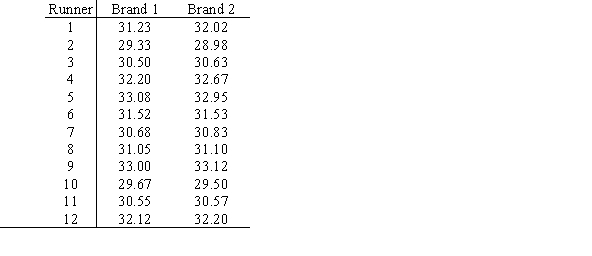Twelve runners are asked to run a 10-kilometer race on each of two consecutive weeks.In one of the races,the runners wear one brand of shoe and in the other,a different brand.The brand of shoe they wear in each race is determined at random.All runners are timed and are asked to run their best in each race.The results (in minutes) are given below.  Use the sign test for matched pairs to determine if there is evidence that times using Brand 1 tend to be faster than times using Brand 2.What are the hypotheses we wish to test?
Use the sign test for matched pairs to determine if there is evidence that times using Brand 1 tend to be faster than times using Brand 2.What are the hypotheses we wish to test?
A) H0: = 0 versus Ha: > 0,where = the mean of the differences in running times (Brand 2 - Brand 1) for all runners who run this race twice wearing the two brands of shoes
B) H0: p = 1/2 versus Ha: p 1/2,where p = the proportion of running times using Brand 1 that are faster than times using Brand 2
C) H0: p = 1/2 versus Ha: p > 1/2,where p = the proportion of running times using Brand 1 that are faster than times using Brand 2
D) H0: population median = 0 versus Ha: population median 0,where the median of the differences in running times for all runners who run this race twice wearing the two brands of shoes is measured for Brand 2 - Brand 1
Correct Answer:
Verified
Q33: A one-sample t test of H0:
Q34: Twelve runners are asked to run a
Q35: A study was to be undertaken
Q36: A random sample of 20 observations produced
Q37: Twelve runners are asked to run a
Q39: Do students tend to improve their
Q40: A study was to be undertaken
Q41: Robustness refers to how sensitive probability calculations
Q42: The sign test is more powerful than
Q43: The probability calculations from a t procedure
Unlock this Answer For Free Now!
View this answer and more for free by performing one of the following actions

Scan the QR code to install the App and get 2 free unlocks

Unlock quizzes for free by uploading documents